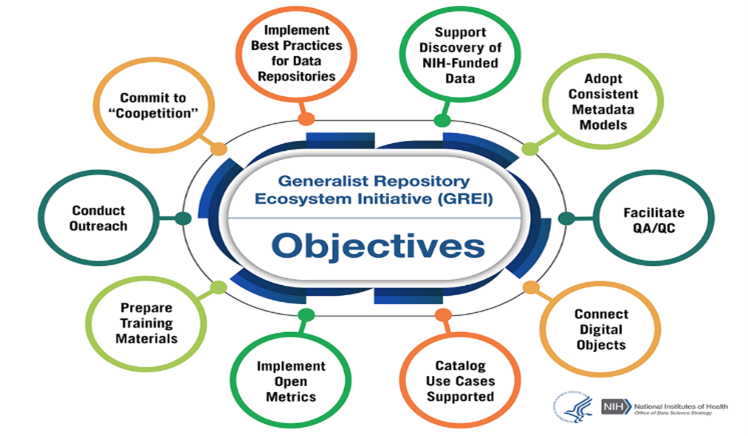GREI Vision & Mission
The vision of the Generalist Repository Ecosystem Initiative (GREI) is to develop collaborative approaches for data management and sharing through the inclusion of generalist repositories in the NIH data ecosystem. GREI also aims to better enable search and discovery of NIH-funded data in generalist repositories.

GREI’s mission is twofold:
The primary mission is to establish a common set of cohesive and consistent capabilities, services, metrics, and social infrastructure across generalist repositories.
The secondary mission is to raise general awareness and help researchers adopt FAIR principles to better share and reuse data.
ODSS supports this initiative to enhance the biomedical data ecosystem and help researchers find and share data from NIH-funded studies in generalist repositories. GREI was envisioned as a result of the Generalist Repositories Pilot and the 2020 NIH workshop on the role of Generalist Repositories to enhance data discoverability and reuse.
GREI Awardees
GREI currently includes seven established generalist repositories that work together to establish consistent metadata, develop use cases for data sharing and reuse, train and educate researchers on FAIR data and the importance of sharing.

Dataverse
Dryad
Figshare
Mendeley Data
Open Science Framework (OSF)
Vivli
Zenodo (CERN and Northwestern University)
In general, NIH does not endorse or require sharing in any specific repository and encourages researchers to select the repository that is most appropriate for their data type and discipline (though such specification does exist for particular initiatives).
Resources
| GREI GitHub | Explore completed and planned coopetition work and share feedback via the Discussions feature |
| GREI Zenodo Community | Access GREI coopetition work products, including white papers, use cases, webinars, guide resources, and conference presentations |
| GREI Community Blog | Read coverage of GREI outputs and activities |
| GREI Webinars and Events | Access recordings, slides, and other resources from GREI webinars and related events |
| GREI Google Group | Join to receive email updates and participate in discussions about GREI |
Contact
For enquiries related to this initiative contact the program office at [email protected]


